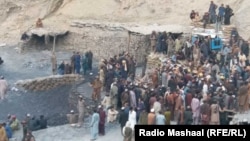Most miners across Pakistan come from a picturesque northwestern region where almost everyone knows someone who has worked in dangerous conditions with little protection or assistance.
Many families in Shangla, an impoverished mountainous district in northwestern Khyber Pakhtunkhwa Province, have lost loved ones to mining accidents, while others struggle to look after those who were injured or who suffer from diseases caused by harsh working conditions.
Ebadullah Khan, an activist in Shangla, says hundreds of people from the district are killed in mining accidents across Pakistan every year.
“Almost every week, someone from Shangla is killed or injured in a mining accident,” he told Radio Mashaal. “Every year, that’s between 300 and 350 people [from Shangla] who are killed in such mishaps.”
Just this week, Shangla received several dead bodies as rescuers recovered 14 miners who had been trapped in a coal mine in the southwestern province of Balochistan, where many Shangla residents work in coal and chromite mines. In May, more than 20 Shangla residents were killed in another accident near Quetta, Balochistan’s capital.
Alibash Khan, another activist, says the Alpuri part of Shangla has suffered most, with graveyards in some villages exclusively filled by young men killed in mines.
“Every third family has lost at least one member to a mining accident,” he told Radio Mashaal. “Many more are trying to look after family members who have damaged their spines or contracted debilitating diseases while working in mines. Their condition is truly heart-wrenching.”
Hafiz Ullah was only 13 when he first began working in a coal mine. His mother stopped him from working after he lost his father and brother in a recent mining incident.
“My mother is on the verge of a nervous breakdown. Although we are very poor, she forces me to stay at home,” he told Radio Mashaal. “My brother was only 22 when he was killed in a mining accident.”
Hussain Ali, a 28-year-old father of two, is bedridden after a mining accident damaged his spine in Khyber Pakhtunkhwa’s Cherat district in 2016. He says the lure of better wages attracted him to mining.
“Working in mining is like inviting certain death, but poor people are drawn by the promise of a bit more money,” he said.
According to the Pakistan Central Mines Labor Federation, nearly 200 workers die each year in coal mining accidents alone. Many are simply buried whenever mines collapse. Poisonous gases, explosives, coal dust, and malfunctioning equipment cause additional deaths, diseases, and injuries. Poor working conditions, lax safety regulations, and little oversight contribute to accidents at all kinds of mines.
Studies by the Pakistani government and the United Nations have cited Shangla as one of the poorest regions in the country, with a majority of its 750,000 residents considered living below the poverty level.
Tashfeen Haider, the deputy commissioner or senior civilian administrator of Shangla, says the authorities are now working on ways to reduce the region’s dependence on mining.
“We are trying to utilize government and nongovernmental resources to create jobs in Shangla so that we can prevent its residents from flocking to mining,” he told Radio Mashaal.







